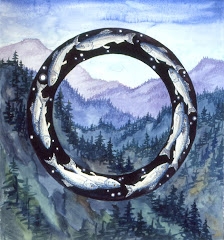I’m not particularly deliberate in the way I paint. Not too much, “I’m going to paint such and such.” It’s more, “Great mother, show me what you want me to paint,” or “Salmon spirit, move my hands to create what you need to be seen.”
I think more about smaller spirits and spirit guides than I do about God. St. Francis had it right, seeing God’s face everywhere, in birds, in tea cups, in daisies on the hillside, in the hill itself. Theories about God don’t move me very much, intimacy moves me. My paintings are about intimacy. So are my poems, just another medium for the same family photos.
Loving God is inseparable from loving earthworms, clean creeks, unpolluted clouds. Being loved by God is inseparable from receiving, feeling, the love willows, jays, thunder give us.
Ecological restoration isn’t just about the material changes we need to make to protect life and health. It’s also about emotional relationship with other beings as equals, as guides, as benefactors. This is the ancient way humans interacted with land and its inhabitants in every culture that has endured sustainably for centuries. It is the new way that will save us. It is also the way of spiritual intimacy with god, however we name, imagine, or worship timeless being.




